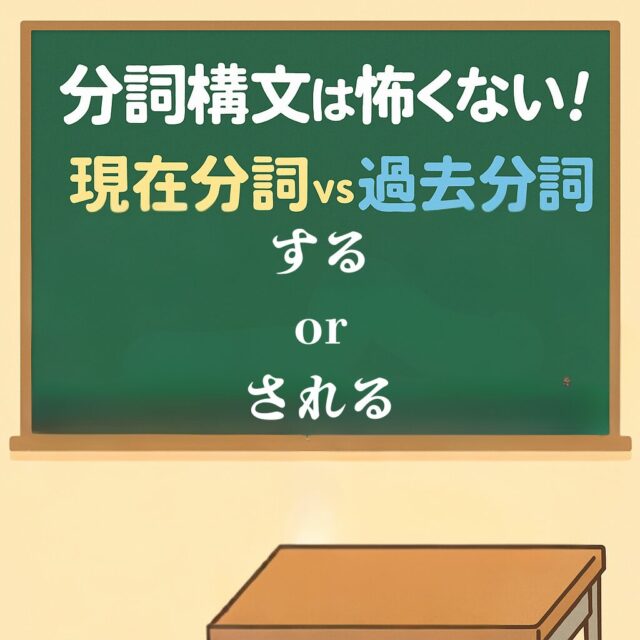📘 読解講座 第8講:意味を添える影の主役 ― 副詞句に注目せよ!
文を読んでいると、「いつ?」「どこで?」「どんなふうに?」「なぜ?」といった情報が自然と頭に入ってきますよね。 実はこれらの情報、副詞句が担っていることがとても多いのです。
副詞句とは、「副詞の働きをする語のまとまり」のこと。特に今回は、前置詞句が副詞句として機能するパターンを中心に学びます。 動詞・形容詞・文全体などに意味を添えて、文の意味を立体的にしてくれる影の主役なんです✨
🧭 例文と修飾対象の明示付き解説
✅ 例文①
She left the party in a hurry.
- 副詞句:
in a hurry(前置詞句) - 修飾対象:
left(動詞) - 意味的役割: 「どのように去ったか(様態)」を示す
✅ 例文②
After the meeting, we went out for lunch.
- 副詞句:
After the meeting(前置詞句) - 修飾対象:
went out(動詞) - 意味的役割: 「いつ出かけたか(時)」を示す
✅ 例文③
He spoke with confidence.
- 副詞句:
with confidence(前置詞句) - 修飾対象:
spoke(動詞) - 意味的役割: 「どのように話したか(様態)」を示す
副詞句は、動詞に限らず形容詞や文全体も修飾する柔軟な存在。
文のどこに意味を添えているのか?を意識することで、読解力は大きくアップします📈
📚 副詞句の4つの代表的パターン
副詞句にはさまざまな形がありますが、以下の4パターンが特によく使われます。それぞれの働きや例文を見てみましょう!
| パターン | 内容の概要 | 修飾できる対象 | 例文 |
|---|---|---|---|
| ① 前置詞句型 | 前置詞 + 名詞の形で、副詞の働きをする | 動詞・形容詞・文全体 | She walked in silence. (どうやって歩いた?) |
| ② 時表現型 | 時を表す語句(前置詞なしの時間名詞など) | 動詞・文全体 | We met last summer. (いつ出会った?) |
| ③ 不定詞句型 | to + 動詞の原形で「目的」「結果」などを示す | 動詞・文全体 | He studies to pass the test. (なぜ勉強?) |
| ④ 分詞句型 | 現在分詞・過去分詞の句が、条件・理由などを補足 | 文全体(または主節の動詞) | Given the weather, we canceled the picnic. (理由) |
すべて「副詞の働き」をするため、主語・述語の関係には直接関わらないのが共通点です。
それぞれの句が文に「いつ」「どこで」「なぜ」「どのように」「どんな条件で」といった意味の補足をします。
🎓 副詞句の読解練習問題
Q1. She decided to move to the countryside after years of living in the busy city because she wanted a more peaceful life.
▼ 解説を見る
文構造:
主語 (S): She
動詞 (V): decided
目的語 (O): to move to the countryside after years of living in the busy city
副詞句: after years of living in the busy city(時)→ to move にかかる
副詞節: because she wanted a more peaceful life(理由)→ 主節全体にかかる
和訳:
長年にわたり忙しい都市に住んだ後、より平穏な生活を望んで、彼女は田舎に引っ越すことを決意した。
Q2. He gained a lot of experience by working closely with skilled professionals in the field over several years.
▼ 解説を見る
文構造:
主語 (S): He
動詞 (V): gained
目的語 (O): a lot of experience
副詞句: by working closely with skilled professionals in the field(手段)→「gained」にかかる
副詞句: over several years(時)→「working」にかかる
和訳:
彼は数年にわたって、その分野の熟練した専門家と密に働くことによって、多くの経験を積んだ。
Q3. The students stayed in the library until closing time to finish their group project before the deadline.
▼ 解説を見る
文構造:
主語 (S): The students
動詞 (V): stayed
副詞句: in the library(場所)→「stayed」にかかる
副詞句: until closing time(時)→「stayed」にかかる
副詞句: to finish their group project before the deadline(目的)→「stayed」にかかる
和訳:
生徒たちは、締切前にグループ課題を終えるため、閉館時間まで図書館に残っていた。
Q4. While walking through the quiet park in the early morning, she came up with a new idea for her novel.
▼ 解説を見る
文構造:
副詞句(文頭): While walking through the quiet park in the early morning(時)→「came up with」にかかる
主語 (S): she
動詞 (V): came up with
目的語 (O): a new idea for her novel
和訳:
早朝の静かな公園を歩いている間に、彼女は小説の新しいアイデアを思いついた。
Q5. He looked extremely confident during the presentation, even though he had been very nervous just moments before it started.
▼ 解説を見る
文構造:
主語 (S): He
動詞 (V): looked
補語 (C): extremely confident
副詞句: during the presentation(時)→「looked」を修飾
副詞節: even though he had been very nervous just moments before it started(譲歩)→ 主節全体を修飾
和訳:
プレゼン中、彼は非常に自信に満ちて見えたが、それが始まるほんの少し前まではとても緊張していた。
🌟 次回予告:読解講座 第9講
今回の講義でも少し現れましたが、次回は副詞節の世界へ本格的に進みます⛵️
「when」「because」「although」などを使った副詞節は、文の意味をぐっと広げる大切なパーツです。
一緒に英文の奥行きを確かめていきましょう✨








